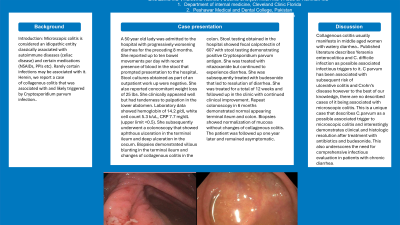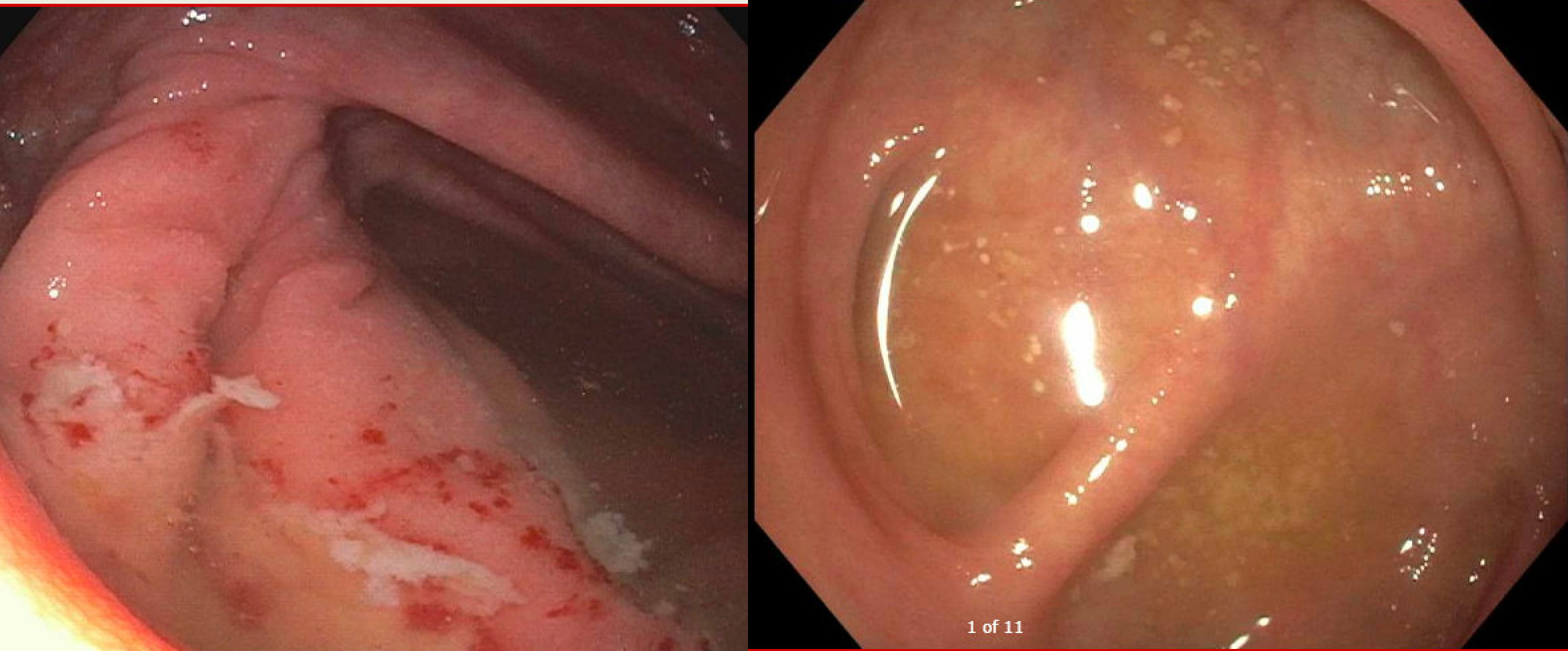Tuesday Poster Session
Category: Colon
P3760 - Cryptosporidium parvum Infection and Collagenous Colitis: A New Association
Tuesday, October 29, 2024
10:30 AM - 4:00 PM ET
Location: Exhibit Hall E

Has Audio

Effa Zahid, MD
Cleveland Clinic Florida
Sunrise, FL
Presenting Author(s)
Effa Zahid, MD1, Haleema Kamila, MBBS2, Osama Sherjeel Khan, MD1, Asad Ur Rahman, MD1
1Cleveland Clinic Florida, Weston, FL; 2Peshawar Medical College, Lahore, Punjab, Pakistan
Introduction: Microscopic colitis is considered an idiopathic entity classically associated with autoimmune diseases, certain medications and rarely certain infections. Herein, we report a case of collagenous colitis that was associated with and likely triggered by Cryptosporidium parvum infection.
Case Description/Methods: A 50 year old lady was admitted to the hospital with progressively worsening diarrhea for the preceding 8 months. She reported up to 10 bowel movements/day with recent presence of blood in the stool and 25 lb weight loss that prompted presentation to the hospital. Stool cultures obtained as part of an outpatient work up were negative. She clinically appeared well but had tenderness to palpation in the lower abdomen. Lab data showed Hb of 14.2 g/dl,WBCs 5.3 k/uL,CRP 7.7 mg/dL (upper limit < 0.5). She subsequently underwent a colonoscopy that showed aphthous ulceration in the terminal ileum and deep ulceration in the cecum (Fig 1). Biopsies demonstrated villous blunting in the terminal ileum and changes of collagenous colitis in the colon. Stool testing obtained in the hospital showed fecal calprotectin of 607 and positive C. parvum antigen testing. She was treated with nitazoxanide but continued to experience diarrhea. She was subsequently treated with budesonide that led to resolution of diarrhea. She was treated for a total of 12 weeks and followed up in the clinic with continued clinical improvement. Repeat colonoscopy in 6 months demonstrated normal appearing terminal ileum and colon (fig 2). Biopsies showed normalization of mucosa without changes of collagenous colitis. The patient was followed up one year later and remained asymptomatic.
Discussion: Collagenous colitis usually manifests in middle aged women with watery diarrhea. Similar to other types of IBD, it may be triggered by environmental changes including medications and rarely infections. Published literature describes Y. enterocolitica and C. difficile infection as possible associated infectious triggers. C. parvum has been associated with subsequent risk of ulcerative colitis and Crohn’s disease however to the best of our knowledge, there are no described cases of it being associated with microscopic colitis. This is a unique case that describes C. parvum as a possible associated trigger to microscopic colitis and interestingly demonstrates clinical and histologic resolution after treatment with antibiotics and budesonide. This underscores the need for comprehensive infectious evaluation in patients with chronic diarrhea.

Disclosures:
Effa Zahid, MD1, Haleema Kamila, MBBS2, Osama Sherjeel Khan, MD1, Asad Ur Rahman, MD1. P3760 - Cryptosporidium parvum Infection and Collagenous Colitis: A New Association, ACG 2024 Annual Scientific Meeting Abstracts. Philadelphia, PA: American College of Gastroenterology.
1Cleveland Clinic Florida, Weston, FL; 2Peshawar Medical College, Lahore, Punjab, Pakistan
Introduction: Microscopic colitis is considered an idiopathic entity classically associated with autoimmune diseases, certain medications and rarely certain infections. Herein, we report a case of collagenous colitis that was associated with and likely triggered by Cryptosporidium parvum infection.
Case Description/Methods: A 50 year old lady was admitted to the hospital with progressively worsening diarrhea for the preceding 8 months. She reported up to 10 bowel movements/day with recent presence of blood in the stool and 25 lb weight loss that prompted presentation to the hospital. Stool cultures obtained as part of an outpatient work up were negative. She clinically appeared well but had tenderness to palpation in the lower abdomen. Lab data showed Hb of 14.2 g/dl,WBCs 5.3 k/uL,CRP 7.7 mg/dL (upper limit < 0.5). She subsequently underwent a colonoscopy that showed aphthous ulceration in the terminal ileum and deep ulceration in the cecum (Fig 1). Biopsies demonstrated villous blunting in the terminal ileum and changes of collagenous colitis in the colon. Stool testing obtained in the hospital showed fecal calprotectin of 607 and positive C. parvum antigen testing. She was treated with nitazoxanide but continued to experience diarrhea. She was subsequently treated with budesonide that led to resolution of diarrhea. She was treated for a total of 12 weeks and followed up in the clinic with continued clinical improvement. Repeat colonoscopy in 6 months demonstrated normal appearing terminal ileum and colon (fig 2). Biopsies showed normalization of mucosa without changes of collagenous colitis. The patient was followed up one year later and remained asymptomatic.
Discussion: Collagenous colitis usually manifests in middle aged women with watery diarrhea. Similar to other types of IBD, it may be triggered by environmental changes including medications and rarely infections. Published literature describes Y. enterocolitica and C. difficile infection as possible associated infectious triggers. C. parvum has been associated with subsequent risk of ulcerative colitis and Crohn’s disease however to the best of our knowledge, there are no described cases of it being associated with microscopic colitis. This is a unique case that describes C. parvum as a possible associated trigger to microscopic colitis and interestingly demonstrates clinical and histologic resolution after treatment with antibiotics and budesonide. This underscores the need for comprehensive infectious evaluation in patients with chronic diarrhea.

Figure: Fig A (Cecum with visible Ulceration on left side) and Fig B (Normal appearing cecum after 6 months of treatment on right side)
Disclosures:
Effa Zahid indicated no relevant financial relationships.
Haleema Kamila indicated no relevant financial relationships.
Osama Sherjeel Khan indicated no relevant financial relationships.
Asad Ur Rahman: Abbvie – Speakers Bureau.
Effa Zahid, MD1, Haleema Kamila, MBBS2, Osama Sherjeel Khan, MD1, Asad Ur Rahman, MD1. P3760 - Cryptosporidium parvum Infection and Collagenous Colitis: A New Association, ACG 2024 Annual Scientific Meeting Abstracts. Philadelphia, PA: American College of Gastroenterology.
